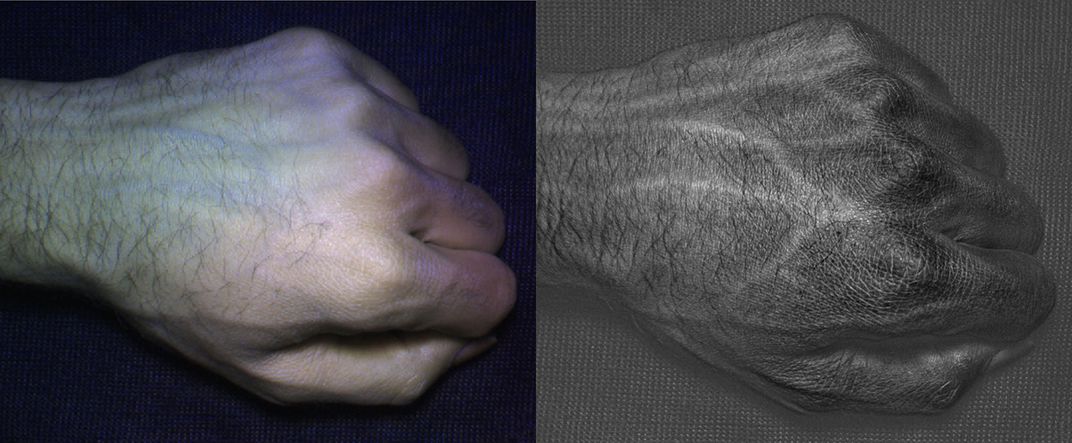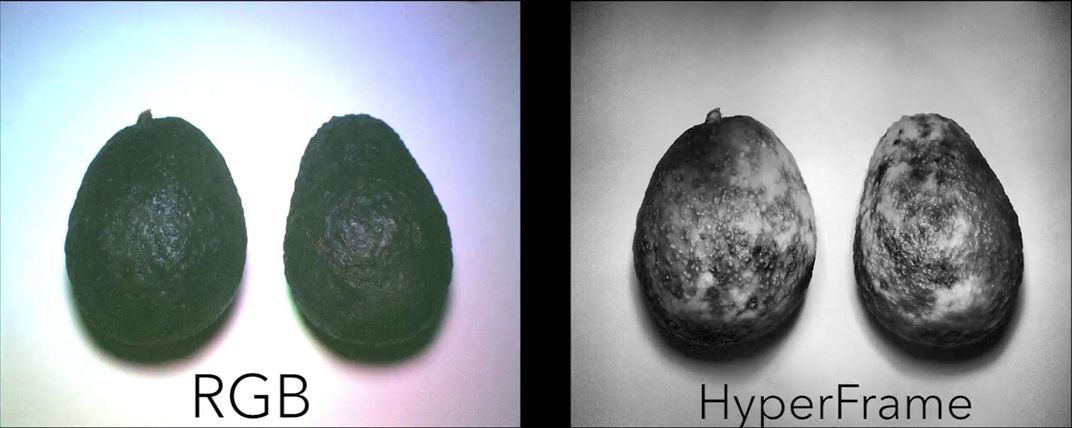This Camera Sees What Your Eyes Can’t
HyperCam, an affordable hyperspectral imaging camera, can tell if your food’s gone bad, among other things
/https://tf-cmsv2-smithsonianmag-media.s3.amazonaws.com/filer/a2/5c/a25cbbb0-4d7b-4cae-afcc-2796b1ba3599/hypercam-still.jpg)
One day, in the not-too-distant future, we may all carry cameras in our pockets that can see far beyond what our eyes are capable of.
That’s the goal of a team of researchers at the University of Washington who, working in conjunction with Microsoft, has developed an affordable hyperspectral camera they call HyperCam.
The human eye, while dazzling in its complexity, can only see a limited range. Of the entire electromagnetic spectrum, our eyes only perceive three color bands—red, green and blue. So scientists have long used hyperspectral imaging—a technology that carves the electromagnetic spectrum into hundreds of bands to create detailed data images beyond what the eye can see—for a variety of purposes. It's used in agriculture and mining to look at things like the mineral content and moisture level of soil. In aerial hyperspectral photographs, certain types of soil or minerals will have specific spectral signatures that form patterns. Food safety inspectors can use hyperspectral cameras to assess foods for nutritional content or contamination by a non-food material.

HyperCam uses both visible light and invisible near-infrared light to peer beneath the surfaces of objects and create patterns to show our eyes what they’re missing. For every picture, it generates an image from 17 different wavelengths. Its integrated software then chooses the best pieces of each image to fit together into a whole. It privileges parts of the image that show things the eye wouldn't ordinarily perceive.
“[HyperCam] automatically tries to define what’s useful in a scene,” explains Mayank Goel, a doctoral student at the University of Washington who works on the HyperCam project. “It exaggerates what the human eye can’t see.”
HyperCam can, for example, see veins beneath human skin. These vein patterns, combined with the camera’s ultra-detailed images of a skin’s surface patterns, can be used for identification purposes. In an experiment involving 25 subjects, HyperCam was able to match photographs of hands and their subjects with more than 99 percent accuracy. This high level of accuracy suggests HyperCam could have potential biometric uses, using skin patterns to unlock smart phones, for example, or even as an ID for online payment purposes.
The ability to make such detailed images of skin patterns could also have a number of medical uses, Goel says. It could, for example, be used to monitor a wound healing over time, capturing fine-grained changes the human eye can’t see.

HyperCam has some interesting potential uses for consumers too. It can easily distinguish between ripe and overripe fruit, and suss out below-the-surface bruises that mar the texture of a pear or an apple. The riper the fruit, the darker it will appear on a HyperCam image. This is because riper fruits are softer; light penetrates the fruit rather than being reflected.
Unlike the hyperspectral cameras used for industrial purposes, which can cost thousands of dollars, HyperCam is only about $800. And the creators say, for just $50, the technology could be implanted in mobile phones.
HyperCam’s technology has limitations. It can’t be used in bright daylight, as too much light will overwhelm its abilities to carve up the spectrum. Even in a very brightly lit grocery store, a user might have to hold a HyperCam fairly close to the produce—say one foot or so—to get an accurate reading.
While being able to pick out the best peaches in the market would no doubt be useful, HyperCam’s inventors say it has many more potential uses. And while there are no immediate plans to plant HyperCams in cell phones, the researchers hope to work towards this in the near future.
“We want to work with [other] scientists,” says Goel. “The idea is that we educate people on how they make this camera, and then they can generate it for their own applications.”
/https://tf-cmsv2-smithsonianmag-media.s3.amazonaws.com/accounts/headshot/matchar.png)


/https://tf-cmsv2-smithsonianmag-media.s3.amazonaws.com/accounts/headshot/matchar.png)